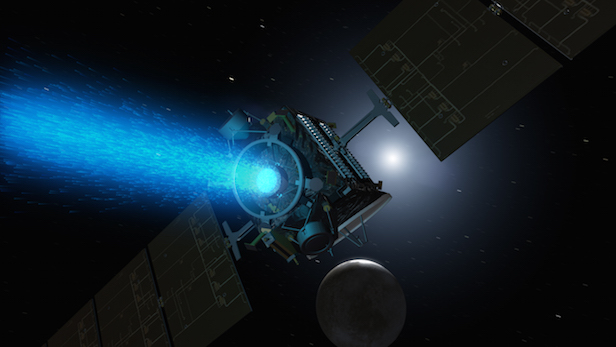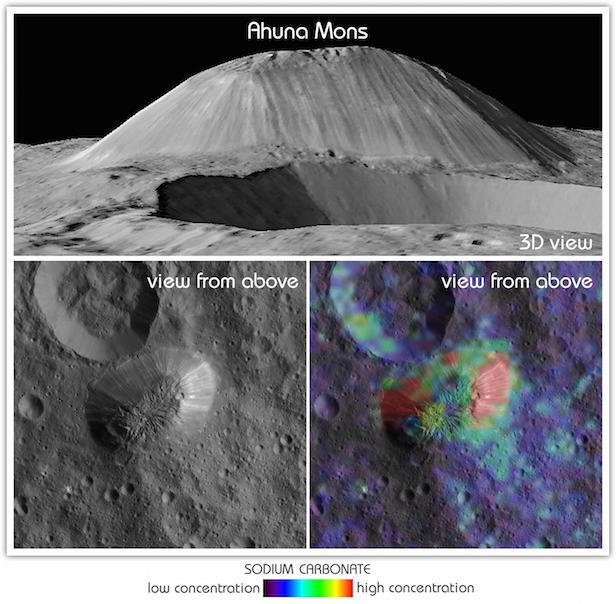Dwarf planet Ceres found to have constantly evolving surface
Observations made by NASA’s Dawn spacecraft has showed constant variation on the rocky world

NASA’s Dawn spacecraft has been at dwarf planet Ceres for over three years. Image credit: NASA/JPL-Caltech
Ceres, the only dwarf planet in our inner Solar System, appears to have a dynamic body that is constantly changing. NASA’s Dawn spacecraft, currently orbiting the small world, has revealed exposed deposits that uncover the evolving material within the crust. Observations taken between April and October 2016 show an increase of ice within the Juling Crater.
Since its arrival at Ceres on 16 July 2011, the Dawn spacecraft’s visible and infrared mapping spectrometer (VIR) has been studying its surface mineralogy. VIR previously detected water ice in a dozen sites on Ceres, which has large implications for future space exploration. This new study has now revealed the abundance of ice on the northern wall of the Juling Crater, a crater 20 kilometres (12 miles) in diameter.
“This is the first direct detection of change on the surface of Ceres,” says Andrea Raponi of the Institute of Astrophysics and Planetary Science in Rome. “The combination of Ceres moving closer to the Sun in its orbit, along with seasonal change, triggers the release of water vapour from the subsurface, which then condenses on the cold crater wall. This causes an increase in the amount of exposed ice. The warming might also cause landslides on the crater walls that expose fresh ice patches.”
In a second study, Dawn’s VIR instrument revealed how variable Ceres’ crust is, this implies the surface is changing and it is being replenished by newly-exposed material. Such substances include carbonates, which are common on the planet’s surface, and are believed to have formed within an ocean. For instance, sodium carbonates have been seen to shine bright within the Occator Crater, while a substance with a similar composition has been found in the Oxo Crater and Ahuna Mons.

Ceres’ tallest mountain, Ahuna Mons, is one of the few sites where a significant amount of sodium carbonate is found. Image credit: NASA/JPL-Caltech/UCLA/MPS/DLR/IDA/ASI/INAF
A prior study to identify and examine 12 sites rich in sodium carbonates on the surface of Ceres was led by Giacomo Carrozzo of the Institute of Astrophysics and Planetary Science. This team extensively studied areas of just a few square miles in the hunt for water in the form of carbonates. This was a revolutionary discovery, as it was the first time a hydrated carbonate had been discovered on any other planetary body other than Earth. It has since given us a completely new idea of how a dwarf planet’s chemical composition evolves.
It has been proven that that water ice does not stay stable on the surface of Ceres over long periods, with the exception of when it’s being concealed. In the new research, the Juling Crater was cloaking the water ice and thus preserving it. Also, hydrated carbonates would naturally dehydrate over a much longer period, lasting a few million years. “This implies that the sites rich in hydrated carbonates have been exposed due to recent activity on the surface,” Carrozzo says.
There is much irregularity to Ceres, as its uneven material, ice and carbonates, exposed by impacts, landslides and cryovolcanism, suggest that the dwarf planet’s crust is not consistent in its composition. These heterogeneities could have formed in two possible scenarios; one idea is that it is due to the freezing of Ceres’ original ocean, which developed inside its rocky layering. The other idea is that it is the result of large impacts or intrusions brought about by ice volcanoes.
“Changes in the abundance of water ice on a short timescale, as well as the presence of hydrated sodium carbonates, are further evidence that Ceres is a geologically and chemically active body,” concludes Cristina De Sanctis, VIR team leader at the Institute of Astrophysics and Planetary Science.
Keep up to date with the latest reviews in All About Space – available every month for just £4.99. Alternatively you can subscribe here for a fraction of the price!




